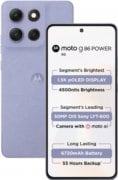- Home
- Mobiles
- Mobiles Reviews
- OnePlus 7 Pro Review
OnePlus 7 Pro Review
Has OnePlus succeeded in delivering a true "ultra-premium" smartphone?

OnePlus 7 Pro packs in a powerful SoC and a set of three cameras at the back
OnePlus, popularly known as the maker of ‘flagship killer' smartphones, has grown over the years to become one of the most successful premium smartphone manufacturers in India. The OnePlus 6 (Review), helped propel the company to the top spot in the Indian premium phone segment, beating even Apple and Samsung. Since the launch of that model, OnePlus has continued to dominate this segment with the updated OnePlus 6T (Review).
However, things took a slightly different turn in the first quarter of 2019, as Samsung's Galaxy S10 trio managed to wrestle the top position back from OnePlus. Samsung's aggressive pricing in India also meant there wasn't a very big price disparity between some its phones and OnePlus' offerings any more. Let's not forget the ongoing price war in the premium smartphone segment which has resulted in huge discounts on premium phones — the Apple iPhone XR (Review) being one of the prime examples.
In the global scheme of things, Apple, Samsung, and Huawei are still dominating the top three positions. If OnePlus hopes to crack this, it needs a new approach for its 2019 flagship. This is where the OnePlus 7 and the OnePlus 7 Pro come in. The trend of launching multiple flagships together has caught up with OnePlus, but rather than just having two very similar phones with only different display and battery sizes, the OnePlus 7 and OnePlus 7 Pro serve different purposes.
The OnePlus 7 is aimed at people who still want a ‘flagship killer', which is to say, a phone with top-end hardware but at a relatively low price. The OnePlus 7 Pro, on the other hand, is positioned as a proper flagship, for those who aren't shy of splurging Rs. 50,000 or more on a phone. These buyers, who would typically go for a Samsung, Apple, or Google phone, can now consider a OnePlus option too. At least, that's what the company hopes will happen.
As good as the OnePlus 6T was, it lacked some luxuries such as waterproofing, wireless charging, and even an elaborate camera setup. With the 7 Pro, OnePlus is taking the opportunity to go all-out and deliver a truly stunning product. But has it managed to succeed?
OnePlus 7 Pro design
From a design perspective, OnePlus has done a pretty good job. The OnePlus 7 Pro gets an all new design, with curved glass on the back back and front sandwiching an aluminium frame in the middle. The design reminds us a lot of the Samsung Galaxy S10+ (Review) and Huawei P30 Pro (Review), which is a good thing
However, all this glass and metal has made the phone quite heavy — 206g to be precise — and this is something you'll notice immediately when you pick it up. The OnePlus 7 Pro is also a bit top-heavy, probably due to the three rear cameras and the pop-up selfie camera, which doesn't make single handed use easy. The smooth finish for the back also makes this phone quite slippery, especially for one-handed use.
Our unit is the Nebula Blue colour version, which looks gorgeous. The frame and the glass back have a gradient finish, which starts with a navy blue (almost black) shade at the top and transitions to a cerulean blue at the bottom. The matte finish diffracts light, which alters the blue hue depending on the angle you look at it. There are also a Mirror Grey option, which has a glossy surface, and Almond, which has a soft gold finish.
![]() The Nebula Blue version of the OnePlus 7 Pro looks really good
The Nebula Blue version of the OnePlus 7 Pro looks really good
In the front, you get a massive 6.67-inch ‘Fluid AMOLED' display, which for the first time for a OnePlus device, has a QHD+ resolution. Images and text looks sharp, thanks to a pixel density of 516ppi. The resolution automatically scales between full-HD+ and QHD+ depending on what you're doing, or you can force it to run at either of these resolutions. You also get very slim bezels all around, which makes any interaction with the phone feel immersive.
The display panel runs at 90Hz by default, which makes scrolling through the interface and Web pages feel very smooth and fluid. You can set this to 60Hz, if you want to squeeze out a bit more battery life, but given the large battery, we didn't find any reason to downgrade. The display is also HDR 10+ certified, which means you'll be able to take advantage of HDR programming in streaming apps such as Netflix and even YouTube.
Overall, we found the display to have excellent sunlight legibility, punchy colours, and among the best black levels we've ever seen. These characteristics have also earned it some high praise from the likes of DisplayMate.
The physical buttons are easy to reach with your thumb and fingers but feel a little too stiff. You also get the trademark alert slider, which has been around since the OnePlus 2 (Review). We said goodbye to the headphone socket on the OnePlus 6T and it doesn't seem like it's coming back. The dual-SIM tray is at the bottom, along with the USB Type-C port and a speaker. Another first for a OnePlus smartphone is the presence of stereo speakers, as the earpiece acts as a second channel for audio.
![]() The OnePlus 7 Pro features a pop-up selfie camera
The OnePlus 7 Pro features a pop-up selfie camera
The OnePlus 7 Pro uses an in-display fingerprint sensor, which the company says is improved thanks to a larger CMOS sensor under the display. In our experience, we found it to be very reliable and quick. The only times it failed to authenticate us was when we didn't have our finger properly placed over the sensor. You can opt for face recognition too, which is usually equally quick, but doesn't work in extremely low light.
There are two features that we've longed for in a OnePlus phone, but sadly, these still haven't made it to the OnePlus 7 Pro. We are of course talking about IP-certified waterproofing and wireless charging. OnePlus has confirmed that the 7 Pro has a water-repellent treatment but it doesn't have an IP rating.
Then there's wireless charging. Pretty much every premium smartphone today offers wireless charging, and even though it's not the fastest way to charge your phone, there's no denying its convenience. Plus, wireless chargers have gotten really affordable, and there's a wide variety to choose from, so not including this feature feels like a missed opportunity.
The OnePlus 7 Pro doesn't come with headphones in the box, but the rest of the accessories are what you'd expect. You get a Warp Charge 30W power adapter in the box, which debuted with the OnePlus 6T McLaren Edition (Review), a USB Type-C cable, a SIM eject tool, stickers, and a clear silicone case. The case makes the phone easier to grip, without making it much fatter, and the clear plastic means you can still see that wonderful blue colour.
OnePlus 7 Pro specifications and software
OnePlus has always used the top-end SoC from Qualcomm for all its flagships, and this one is no different. What makes the 7 Pro special though is that it's the first phone to launch in India with the Snapdragon 855 mobile platform. Compared to the last year's flagship, the Snapdragon 845, the new 855 processor offers a bunch of improvements.
The Snapdragon 855 is built on a 7nm fabrication process so it should be more power efficient (claimed to be up to 30 percent better), and the new CPU and GPU are said to be 45 percent and 20 percent faster respectively than those of the outgoing model. What's really interesting is the way the new Kryo 485 CPU cores have been designed.
![]() The OnePlus 7 Pro has its USB Type-C port and dual-SIM tray at the bottom
The OnePlus 7 Pro has its USB Type-C port and dual-SIM tray at the bottom
Rather than having two clusters (ARM's BIG.little architecture) of four CPU cores each, the Snapdragon 855 has a single asynchronous core and two clusters of three big and four little cores. Qualcomm is introducing the new concept of a Prime core with its Kryo 485 design, which is a single Cortex-A76 core running at 2.84GHz, which is used for single-threaded applications. Next, we have three Cortex-A76 "big" cores, clocked a little lower at 2.42GHz. Finally, we have four smaller Cortex-A55 cores running at 1.8GHz.
The Prime design allows Qualcomm to use just a single CPU core for tasks such as scrolling through webpages and launching an app, instead of activating multiple cores, thereby conserving power.
The OnePlus 7 Pro is also loaded with ample RAM. You can choose between 6GB, 8GB, and even a maddening 12GB of LPDDR4X RAM, which is the version we have for review. It's also one of the few smartphones out there to feature the brand new UFS 3.0 flash storage standard, the only other so far being the Samsung Galaxy Fold. This new standard theoretically doubles the bandwidth of UFS 2.1 storage, which is what most premium phones of this generation use. This means you can expect faster app launches and snappier system response.
Other specifications include NFC, Bluetooth 5, dual-band Wi-Fi 802.11ac, Gigabit LTE, dual 4G VoLTE, support for five satellite navigation systems, and the usual suite of sensors. It's worth noting that FM radio and Wi-Fi 6 aren't supported.
The OnePlus 7 Pro ships with a new version of OxygenOS (v9.5), which is based on Android 9 Pie. Our unit also had the April 2019 security patch. Many of its features are similar to what we've already seen in the current build on phones such as the OnePlus 6T, but there are some new additions too, which we'll cover here.
Gaming mode gets a new sub-mode called Fnatic mode. With this enabled, all notifications and calls will be blocked with no exceptions, all SoC resources will be directed towards the game being played, and the secondary SIM (the one not being used for data) will be disabled temporarily in order to prioritise the signal strength of the main SIM. You can choose which games engage Gaming mode automatically when you launch them. You can also enable Gaming mode from the notification shade and toggle between the standard and Fnatic modes when needed. This works as described. If you're using Wi-Fi, Fnatic mode doesn't disable either SIM.
![]() Some of the new features added to OxygenOS 9.5 running on the OnePlus 7 Pro
Some of the new features added to OxygenOS 9.5 running on the OnePlus 7 Pro
OxygenOS also now gets a built-in screen recorder. You can adjust the resolution (up to 1080x2340), bit-rate, audio source, and video orientation, and also choose whether or not to record your touch inputs. This can be activated from the notification shade too, and you'll see a floating bar with controls letting you start, pause, and stop recording at any time.
There's a screenshot editor, which lets you annotate and crop your screenshots, similar to what iOS 12 offers. You can also send quick replies in certain chat apps such as Instagram and WhatsApp, when using the phone in landscape mode. The floating keyboard lets you quickly reply to messages without having to leave your current app.
Then there's Zen Mode, which is OnePlus' way of getting users to do a little digital detox every now and then. You can manually enable Zen Mode, which disables all of the phone's functionality except for being able to make and receive emergency calls and take photos for 20 minutes. Once activated, it cannot be disabled.
There are some other improvements to the OnePlus 7 Pro. An upgraded haptic vibration motor can give multiple levels of feedback, which has been integrated into some games such as Asphalt 9: Legends. RAM Boost is said to learn your usage habits and allocate RAM to more demanding apps, such as games.
Other gestures and shortcuts are similar to what we've already seen in OxygenOS. You can choose between three navigation control styles, as well as multiple motion and screen-off gestures. Android Pie's Digital Wellbeing is present, and there's OnePlus Labs, which lets users try out beta features inspired by feedback from the OnePlus community. At the moment, there's just one feature called DC Dimming, which adjusts the brightness of the display by varying the current supplied to it.
The Quick Launch feature lets you open an app or perform an action such as composing an email when you long-press the fingerprint sensor from the lock screen. You can add up to six shortcuts here. It works well but we didn't find ourselves using it all that much. There isn't much bloatware pre-installed. You get the Community and OnePlus Switch apps, along with Amazon and Netflix, due to their partnership with OnePlus.
OnePlus 7 Pro performance, cameras, and battery life
After using the OnePlus 7 Pro for a few days, we didn't have any complaints with its day-to-day performance. As you would expect, 12GB version offers more RAM than you'll probably ever need. The interface is incredibly snappy and the high display refresh rate makes usage feel very fluid. You can take advantage of this higher refresh rate in some games too, such as a Vainglory.
Single-handed use isn't the easiest given the size and slippery surfaces of this phone, but using it with a case makes it easier to live with.
![]() The OnePlus 7 Pro is powerd by a Qualcomm Snapdragon 855 SoC
The OnePlus 7 Pro is powerd by a Qualcomm Snapdragon 855 SoC
The OnePlus 7 Pro delivers very good CPU and GPU performance. In benchmarks, the phone posted a very strong 3,67,740 points in AnTuTu and 7,272 points in the 3DMark Slingshot test.
The newer UFS 3.0 memory show its strengths in AndroBench, posting high sequential read and write speeds of 1.4GBps and 383MBps respectively, compared to roughly 900MBps and 220MBps for phones such as the Samsung Galaxy S10+ and Huawei P30 Pro. However, there wasn't a very big difference in random read and write speeds among these phones.
The OnePlus 7 Pro had no trouble handling heavy gaming titles in our tests. PUBG Mobile and Asphalt 9: Legends ran very smoothy at their highest settings. It did get a little warm after 15-20 minutes of gameplay but never uncomfortably so.
The stereo speakers can get fairly loud and offer a decent stereo effect. The bottom-firing speaker is more powerful than the earpiece but the overall sound isn't too off-balance. Dolby Atmos provides a nice boost to the bass and mid-range frequencies, and it can be enabled for Bluetooth headphones too.
HDR content looks really good on screen. Colours have very good saturation, viewing angles are excellent, and blacks are inky, which made HDR-compatible shows on Netflix and YouTube very enjoyable to watch.
The camera system on the OnePlus 7 Pro has received major overhaul compared to the OnePlus 6T. At the back, we have a 48-megapixel Sony IMX586 primary sensor, which is the same as the one used in phones such as the Redmi Note 7 Pro (Review). You get an aperture of f/1.6 and optical stabilisation (OIS) as well. Next is an 8-megapixel telephoto camera with 3x optical zoom, OIS and an aperture of f/2.4. Finally, we have a 16-megapixel sensor with an ultra wide-angle lens. This gives you a 117-degree field of view and an aperture of f/2.2.
![]() Landscape shot using OnePlus 7 Pro's primary sensor (tap to see full-sized image)
Landscape shot using OnePlus 7 Pro's primary sensor (tap to see full-sized image)
![]() Macro shot using OnePlus 7 Pro's primary sensor (tap to see full-sized image)
Macro shot using OnePlus 7 Pro's primary sensor (tap to see full-sized image)
![]() Shot using OnePlus 7 Pro's 8-megapixel telephoto camera (tap to see full-sized image)
Shot using OnePlus 7 Pro's 8-megapixel telephoto camera (tap to see full-sized image)
![]() Shot using OnePlus 7 Pro's 16-megapixel wide-angle camera (tap to see full-sized image)
Shot using OnePlus 7 Pro's 16-megapixel wide-angle camera (tap to see full-sized image)
In Auto mode, 48-megapixel frames are oversampled to give you a 12-megapixel picture. You can shoot at the full 48-megapixel resolution in JPEG and RAW, which saves oversampled JPEG and DNG files, in Pro mode. We found it best to stick to the oversampled shots, as images lack detail at the native resolution. We also noticed a weird stuttering issue when panning through a zoomed-in view of any 48-megapixel sample in the gallery.
In daylight landscapes, the OnePlus 7 Pro captured decent details with lively colours. The laser autofocus and PDAF features helped in locking focus quickly, and HDR worked well under harsh sunlight.
When shooting macros, we did encounter an annoying issue — the camera would simply refuse to lock focus on our subject, despite us tapping the viewfinder repeatedly. We also noticed this when shooting videos and when trying to focus on small objects using the telephoto lens. Details were decent in close-up shots but very often, edges tended to lack sharpness.
The telephoto camera comes in handy when you need to get close to your subject. Autofocus speed is slower than with the main sensor, and we had quite a bit of hunting when trying to focus on small objects. The quality of the sensor is decent, and under good light, we managed similar details and saturation levels as with the Samsung Galaxy S10+, but this phone is still no match for the quality of shots produced by the P30 Pro. In low light, like pretty much all smartphones, the OnePlus 7 Pro simply does a 3x digital zoom using the main sensor.
The wide-angle camera lets you capture more of a scene in one frame, but the quality is strictly average. Compared to Samsung and Huawei's offerings, colours looked muted, even under bright sunlight, and objects lacked definition. Low-light landscapes suffered the most as the aperture isn't wide enough to let enough light into the sensor.
The primary sensor on the other hand did a much better job with low-light shots. Noise was handled well and there was good detail in distant objects. Nightscape mode gives you a brighter image, with a bit more detail and better colours. Macros looked good too, although zooming in revealed slightly burry edges even under ample artificial light.
![]() Shot using OnePlus 7 Pro's primary sensor (tap to see full-sized image)
Shot using OnePlus 7 Pro's primary sensor (tap to see full-sized image)
![]() Low-light shot, using OnePlus 7 Pro's 16-megapixel wide-angle camera (tap to see full-sized image)
Low-light shot, using OnePlus 7 Pro's 16-megapixel wide-angle camera (tap to see full-sized image)
![]() Low-light shot with OnePlus 7 Pro's 3x (digital) zoom (tap to see full-sized image)
Low-light shot with OnePlus 7 Pro's 3x (digital) zoom (tap to see full-sized image)
![]() Low-light sample, shot using OnePlus 7 Pro's primary sensor (tap to see full-sized image)
Low-light sample, shot using OnePlus 7 Pro's primary sensor (tap to see full-sized image)
![]() Shot using OnePlus 7 Pro's Portrait mode (tap to see full-sized image)
Shot using OnePlus 7 Pro's Portrait mode (tap to see full-sized image)
There's Portrait mode, which takes a little coaxing to work well when shooting objects. You can't adjust the level of blur though, either before or after you're taken a shot. When shooting people, edge detection was good and skin tones looked natural, but shots weren't as sharp as we would have liked. This got worse when we tried to shoot Portrait shots indoors. The main culprit seems to be the telephoto sensor, which is used for Portrait shots.
We now come to the selfie camera, which is a fixed-focus 16-megapixel unit. In daylight, skin tones were handled well, but shots looked a bit flat overall and colours didn't really pop all the time. HDR worked well, properly exposing our subjects and backgrounds when shooting against the light. You get Portrait mode with the front camera too, and it did a decent job but wasn't convincing all the time. In low-light, selfies looked grainy and lacked detail.
The pop-up mechanism for the front camera is silent and very quick, which works well for face recognition. OnePlus says this mechanism has been tested to run over 300,000 times, which should be enough to last a typical user a good five years or more. There's also a safety mechanism, which automatically retracts the camera when the phone is in free-fall, and we found that this worked as described.
The OnePlus 7 Pro is capable of shooting 4K video at up to 60fps, with a five minute limit per clip. When shooting during the day at 4K 30fps (10 minute limit) and 1080p 30fps, stabilisation was excellent. However, at night, there was a distracting shimmer at either resolution, even with subtle movements. At 1080p in daylight, video quality was good, but at 4K, colours were wildly exaggerated. 60fps at both resolutions looked good, but once again, colours at 4K were oversaturated and looked awful. There's no focus tracking, which we missed sorely. You can lock focus (which also locks exposure) but there's no way allow the camera to continuously track a subject.
Other shooting modes include slow-motion video at 1080p 240fps or 720p 480fps, panorama, and timelapse video. The camera app is well designed and easy to use. There's a ‘Smart Scene Detection' toggle which reads detects scenes, and provides suggestions. It can recognise things like QR codes, email addresses, URLs, etc. The problem is, it can only detect one thing at a time, so if a business card has an address, URL, and an email address, it will detect only one of them, or at times, nothing since it can't figure out which one to grab. The recognised text shows up at the bottom of the viewfinder with a related app icon letting you directly call a number or begin composing an email.
Battery life was pretty solid in our experience. The 4000mAh battery lasted for 14 hours and 29 minutes in our HD video battery loop test, which is quite good. With actual usage, we easily managed to go past the 24 hour mark, even after playing heavy games and shooting a lot of pictures. With slightly more frugal usage, we managed to go a day and half on one charge.
The OnePlus 7 Pro ships with Warp Charge 30 power adapter. With this, we were able to charge the phone from zero to about 61 percent in half an hour, and up to 94 percent in an hour. This phone will also charge quickly with older OnePlus Dash chargers too, just not as fast as with the bundled one.
Verdict
There's a lot to like about the OnePlus 7 Pro. If you consume a lot of media on a daily basis, then this phone is sure to keep you happy. The display is among the best we've come across. Its massive size and the lack of interruption from a notch or hole-punch make watching video and playing games all the more enjoyable. The stereo speakers complement this well very well too.
Then there's this phone's raw power. The Snapdragon 855 SoC runs pretty much anything you throw at it, without breaking a sweat. Add to that a lean and well-optimised operating system, and you get one of the best Android experiences outside the Pixel universe. The cameras have gotten a nice upgrade too, with some handy secondary sensors for zoomed-in and wide-angle shots.
However, if we're treating this as an "ultra-premium" smartphone, then it's still missing quite a few luxuries that should come with the territory. An IP rating for water and dust resistance would probably be tough to achieve for phone with a physically moving part, but there's no excuse for leaving out wireless charging. The cameras also seem like they need some polish, especially in the video and autofocus department.
The OnePlus 7 Pro is only the first of many Snapdragon 855 phones that will launch in India. The Asus ZenFone 6 is another phone that's confirmed to have this chipset and will be launching really soon. We can also expect budget power houses such as the Poco F2, which will probably undercut both OnePlus and Asus, if Xiaomi plays its cards right. Let's not forget the vanilla OnePlus 7 itself, which may lack the fancy new design and elaborate camera setup, but still retains the most powerful SoC, at a lower price.
For the price of the 12GB OnePlus 7 Pro, there's really nothing else on the market yet that will give you this amount of RAM and storage. Add to that the powerful processor, good battery life, and excellent display, and you have yourself a good package overall.
Is OnePlus 7 Pro an iPhone, Samsung Killer or yet another pretender? We discussed this on Orbital, our weekly technology podcast, which you can subscribe to via Apple Podcasts or RSS, download the episode, or just hit the play button below.
For the latest tech news and reviews, follow Gadgets 360 on X, Facebook, WhatsApp, Threads and Google News. For the latest videos on gadgets and tech, subscribe to our YouTube channel. If you want to know everything about top influencers, follow our in-house Who'sThat360 on Instagram and YouTube.
Related Stories
- Samsung Galaxy Unpacked 2025
- ChatGPT
- Redmi Note 14 Pro+
- iPhone 16
- Apple Vision Pro
- Oneplus 12
- OnePlus Nord CE 3 Lite 5G
- iPhone 13
- Xiaomi 14 Pro
- Oppo Find N3
- Tecno Spark Go (2023)
- Realme V30
- Best Phones Under 25000
- Samsung Galaxy S24 Series
- Cryptocurrency
- iQoo 12
- Samsung Galaxy S24 Ultra
- Giottus
- Samsung Galaxy Z Flip 5
- Apple 'Scary Fast'
- Housefull 5
- GoPro Hero 12 Black Review
- Invincible Season 2
- JioGlass
- HD Ready TV
- Laptop Under 50000
- Smartwatch Under 10000
- Latest Mobile Phones
- Compare Phones
- iQOO Z10 Turbo+
- Vivo T4R 5G
- Ulefone Armor 33 Pro
- Ulefone Armor 33
- Redmi Note 14 SE 5G
- Lava Blaze Dragon 5G
- Infinix Smart 10
- Realme 15 Pro 5G
- Samsung Galaxy Book 4 Edge
- Acer Nitro Lite 16
- Honor Pad X7
- Honor Pad GT 2 Pro
- CMF Watch 3 Pro
- boAt Valour Watch 1 GPS
- TCL C72K QD Mini‑LED TV
- Haier 43 Inch QLED Ultra HD (4K) Smart TV (43H6E)
- Asus ROG Ally
- Nintendo Switch Lite
- Haier 1.6 Ton 5 Star Inverter Split AC (HSU19G-MZAID5BN-INV)
- Haier 1.6 Ton 5 Star Inverter Split AC (HSU19G-MZAIM5BN-INV)



















